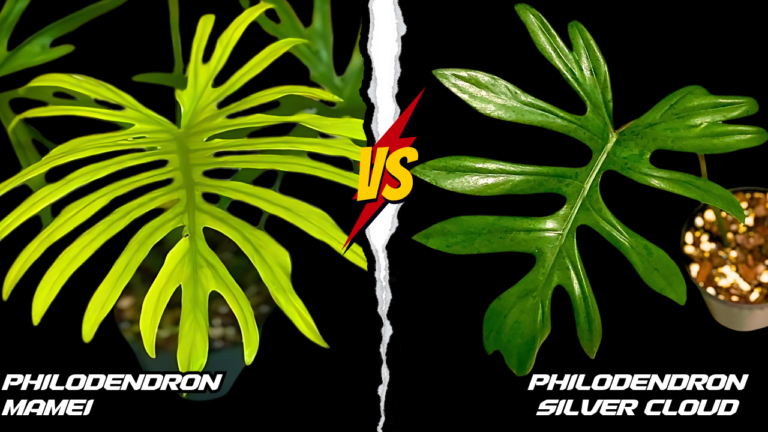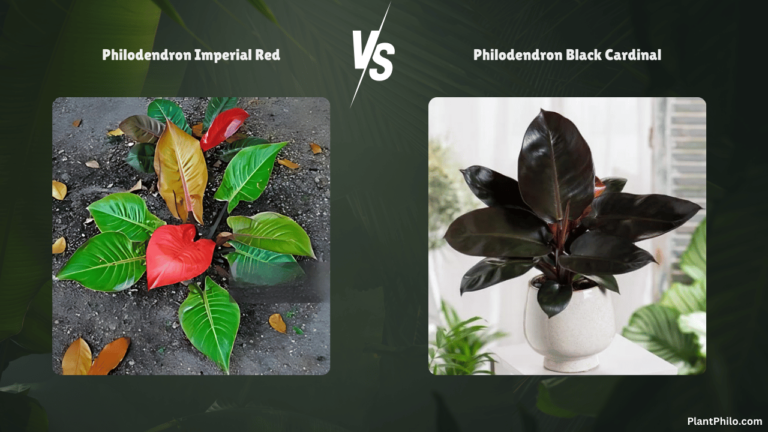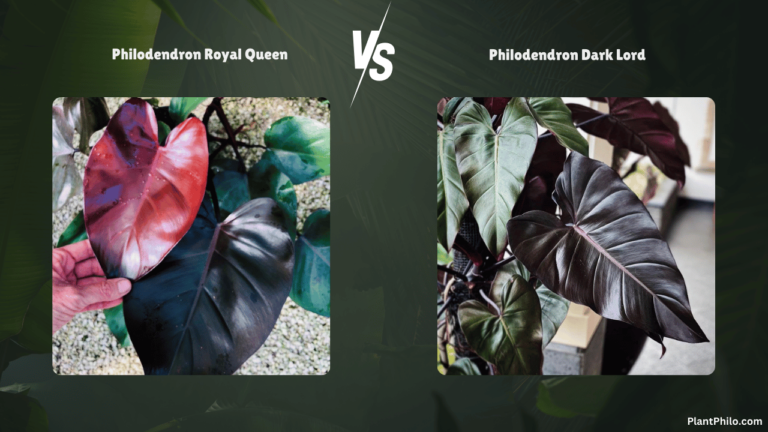Philodendron Gloriosum vs. Splendid: Leaf by Leaf Differences, Care, and More
Philodendron Gloriosum and Splendid, are they twins, distant cousins, or entirely different species? However, Philodendrons are adored by houseplant enthusiasts for their striking leaves and ease of care. Among the many varieties, Philodendron Gloriosum and Philodendron Splendid are two favorites. They are captivated by their distinct beauty, yet they often confuse those trying to distinguish between them. This guide aims to clarify these differences and help you decide which plant best fits your home and lifestyle.
Philodendron Gloriosum hails from Colombia and Ecuador, growing low along the ground with its large, heart-shaped leaves. In contrast, Philodendron Splendid is a hybrid with climbing tendencies, often reaching impressive heights when supported by a moss pole or trellis. Both plants have velvety leaves, but their shape, size, and growth habits can tell them apart.
When it comes to care, both Gloriosum and Splendid thrive in similar conditions—favoring bright, indirect light, moderate watering, and high humidity. Choosing between these two might come down to your preference for a creeping plant (Gloriosum) versus a climbing one (Splendid) and which visual style you find most appealing for your living space.
Key Takeaways
- Gloriosum has broad, heart-shaped leaves and a creeping growth habit.
- Splendid is a climbing hybrid with more elongated leaves.
- Both prefer bright, indirect light and high humidity.
Background and Origins
Philodendron Gloriosum and Philodendron Splendid are both sought-after plants for their distinctive appearances and growth habits. Knowing their backgrounds can help you appreciate their unique characteristics and choose the right one for your collection.
Philodendron Gloriosum
The Philodendron Gloriosum is native to the tropical rainforests of Colombia and Ecuador. This plant thrives in humid, shaded environments where it can spread along the forest floor.
It is a creeping plant, meaning it grows horizontally rather than vertically. This growth habit makes it well-suited for wide pots or terrariums.
One of the most striking features of Philodendron Gloriosum is its large, velvety leaves. These heart-shaped leaves can reach up to 3 feet in length. The leaves are typically deep green with prominent white or pale green veins, adding to the plant’s striking appearance.
Philodendron Splendid
Philodendron Splendid is a hybrid created by crossing Philodendron Melanochrysum and Philodendron Verrucosum. This hybrid combines the best traits of both parent plants and is known for its climbing nature.
Unlike the creeping nature of Gloriosum, Philodendron Splendid uses aerial roots to climb. It is ideal for growing on moss poles or trellises, making it a great option for those who prefer vertical growth.
The leaves of the Philodendron Splendid are also velvety but are more elongated compared to Gloriosum. The veins are more defined, creating a textured look. The D-shaped petioles are another distinguishing feature. New leaves can emerge with a lighter green hue, sometimes with a pink tinge, adding to its visual appeal.
Visual Comparison: Leaves
When looking at Philodendron Gloriosum and Splendid, key differences in their leaves can help you identify each plant. These include variations in shape, size, texture, color, and petioles.
| Feature | Philodendron Gloriosum | Philodendron Splendid |
| Origins | Native to Colombia and Ecuador | Hybrid (P. melanochrysum x P. verrucosum) |
| Growth Habit | Creeping/Crawling | Climbing |
| Leaf Shape | Broader, heart-shaped | Narrower, elongated |
| Leaf Size | Larger | Slightly smaller |
| Leaf Texture | Velvety, soft | Velvety, slightly thicker |
| Leaf Color | Deep green with white/pale green veins | Deep green with prominent white veins |
| New Leaf Color | Bronze/reddish | Lighter green, sometimes pink tinge |
| Petiole Shape | Round | D-shaped |
| Veins | Less raised | More raised and pronounced |
| Ideal Support | Wide pots, terrariums | Moss poles, trellises |
| Cataphylls | Persist longer | Dry and fall off quicker |
| Price | Generally lower | Generally higher |
| Availability | More common | Less common |
Additional Notes:
- Leaf Size: While Gloriosum leaves tend to be larger, both plants can produce similarly sized leaves under optimal conditions.
- Leaf Texture: The difference in texture is subtle and may not be immediately noticeable.
- Leaf Color: The color difference is most apparent in new leaves, while mature leaves can look very similar.
- Petiole Shape: The D-shaped petiole of Splendid is a key distinguishing feature, but it’s best to observe multiple leaves to be sure.
Shape
Philodendron Gloriosum leaves are broader and heart-shaped with a rounded base. The shape is pronounced and makes the plant easily recognizable.
Philodendron Splendid, in contrast, has more elongated and narrower leaves. The heart shape is less defined compared to Gloriosum. This subtler shape difference is one of the ways to distinguish between the two.
Size
The leaves of Philodendron Gloriosum are typically larger, growing up to 12 inches or more. This size contributes to its bold presence in any plant collection.
Philodendron Splendid also has large leaves, but they are often slightly smaller than those of Gloriosum. Though both can feature similarly impressive leaf sizes, Gloriosum’s leaves generally surpass in overall dimensions.
Texture
Both plants have a velvety texture due to fine hairs on their leaf surfaces. This velvety texture is a common trait among many philodendrons and adds to their aesthetic appeal.
Philodendron Splendid leaves tend to be slightly thicker. This subtle difference in thickness combined with texture variations can help in distinguishing between them, especially when comparing side-by-side.
Color
Philodendron Gloriosum features deep green leaves with prominent white veins. These veins are noticeable but not substantially raised. New leaves often emerge with a bronze or reddish hue, adding an extra layer of visual interest.
Philodendron Splendid leaves are also deep green but feature more raised and pronounced veins. These veins create a textured appearance that stands out more than in Gloriosum. New leaves in Splendid are typically lighter green and sometimes sport a slight pink tinge.
Petioles (Leaf Stalks)
A distinguishing feature is the petioles. Philodendron Gloriosum has round petioles, which support its broader leaves well.
Philodendron Splendid, however, has D-shaped petioles. This characteristic can be a quick visual cue when trying to differentiate between the two plants. This difference in petiole shape is practical for identification purposes.
Growth Habit and Structure
Philodendron Gloriosum and Philodendron Splendid have distinct growth habits that can influence where they thrive best. Understanding their structure will help you decide which is the better fit for your space.
Gloriosum
Philodendron Gloriosum has a creeping or crawling growth habit. This terrestrial plant spreads horizontally along the ground. Its large, velvety leaves lie close to the surface, creating a carpet-like effect.
Because of this spreading nature, Gloriosum is best suited for wide pots or terrariums. When it’s time for repotting, choose a pot that allows horizontal growth. Ensure the potting mix is well-draining to prevent waterlogging.
In its natural habitat, it thrives in moist, shady areas. Indoors, it prefers bright but indirect light. Mimic its natural environment by keeping the soil moderately moist without overwatering.
Splendid
Philodendron Splendid has a climbing growth habit. This plant uses aerial roots to ascend vertical supports like a moss pole or trellis. Its leaves are more upright, growing on longer stems.
The vertical growth makes Splendid ideal for settings where space is limited, but height is available. A sturdy support structure will aid its climb and showcase its striking foliage.
For optimal growth, provide Splendid with bright, indirect light and high humidity. Regular repotting may be required to ensure the roots have ample space to expand. A well-draining soil mix will keep the roots healthy.
Care Requirements
Philodendron Gloriosum and Splendid both require specific conditions to thrive. These include bright, indirect light, consistent humidity, and well-draining soil to avoid overwatering.
Light
Philodendron Gloriosum and Splendid both thrive in bright, indirect light. Direct sunlight can damage their leaves, causing scorch marks or fading. Place them near east or north-facing windows where they receive filtered sunlight. If natural light is insufficient, you can use a grow light to ensure they get enough illumination without the risk of leaf burn.
Water
Both plants prefer moderately moist soil. Water them when the top inch of the soil feels dry to the touch. Ensure that the pot has drainage holes to prevent water from pooling at the bottom, which can lead to root rot. Overwatering is a common issue, so it’s essential to monitor the soil moisture.
Humidity
Philodendron Gloriosum and Splendid both thrive in high humidity, ideally above 60%. If your home environment is dry, consider using a humidifier to maintain adequate humidity levels. Alternatively, placing the plants on a tray filled with pebbles and water can also help increase the surrounding humidity. Regular misting is another way to boost humidity.
Temperature
Maintain temperatures between 65-85°F (18-29°C) for optimal growth. These tropical plants do not tolerate cold drafts well, so keep them away from windows and air conditioning vents. Sudden temperature changes can stress the plants, affecting their overall health and growth.
Soil
Use a well-draining soil mix for both Gloriosum and Splendid. A good mix includes perlite, orchid bark, and leca. This allows for proper aeration and prevents water from becoming stagnant. Avoid using heavy potting soils that retain too much moisture, as this can lead to root rot. Repotting should be done every 1-2 years to refresh soil nutrients.
Soil Mix Recipe:
| Component | Proportion |
| Perlite | 30% |
| Orchid Bark | 30% |
| Leca | 40% |
pH Perfect
Both plants prefer a soil pH that ranges from 5.5 to 6.5. This slightly acidic pH helps the plants absorb nutrients more efficiently.
You can test the soil pH using a home testing kit to ensure it remains within this range. If needed, adjust the pH by adding elements like peat moss to increase acidity or garden lime to reduce it.
Additional Differentiating Factors
When choosing between Philodendron Gloriosum and Philodendron Splendid, you should consider their price, availability, and the appearance of their cataphylls.
Price
Philodendron Splendid is often pricier than Philodendron Gloriosum. This difference stems from its hybrid status and relative rarity. Splendid, being a cross between melanochrysum and verrucosum, attracts collectors and hobbyists, which increases its market value.
On sites like Etsy, you might find Splendid listed for higher prices than Gloriosum. If budget is a concern, Gloriosum might be the better choice for you.
Availability
Gloriosum is generally more available than Splendid. This availability makes Gloriosum easier to find in both local nurseries and online stores. Splendid, due to its hybrid nature and the demand from plant enthusiasts, might be less commonly stocked.
When searching, you may need to explore specialty stores or rare plant listings. If you prefer easier access, Gloriosum is likely a more practical option.
Cataphylls (Sheaths)
The cataphylls of these two plants also differ. Philodendron Gloriosum’s cataphylls tend to persist longer on the stem. This feature can be a useful identification marker. On the other hand, Philodendron Splendid’s cataphylls dry up and fall off more quickly.
This difference can affect the plant’s overall appearance and maintenance. If you like a cleaner look with fewer remnants on the stems, Splendid might appeal to you more.
Choosing the Right Plant for You
When deciding between Philodendron Gloriosum and Philodendron Splendid, consider factors such as space, personal preference, and budget. Each factor plays a crucial role in determining which plant will thrive in your home environment.
Space
Philodendron Gloriosum has a creeping growth habit. It spreads horizontally across the ground. This makes it suitable for wide pots or terrariums where it can crawl and expand. Its leaves can reach up to 3 feet in length, so ensure you have enough horizontal space.
Philodendron Splendid, on the other hand, is a climber. It uses aerial roots to ascend and grow upwards. This plant is ideal for those who have vertical space, such as a moss pole or a trellis. Its more upright growth habit makes it a good choice for smaller areas where floor space is limited but height can be utilized.
Personal Preference
If you like large, heart-shaped leaves, Philodendron Gloriosum might be more appealing. Its leaves are broader and typically larger, with a velvety texture that adds a touch of elegance. New leaves often emerge with a beautiful bronze or reddish hue.
Philodendron Splendid boasts elongated, narrower leaves which are also velvety. Its leaves may have a slight pink tinge when new, giving a different kind of charm. The veins on Splendid are more raised and pronounced, creating a textured look. If you prefer a plant with a more dynamic and climbing appearance, then Splendid could be your choice.
Budget
Both plants can be pricey, but Philodendron Splendid tends to be more expensive. This is due to its hybrid status (a mix of melanochrysum and verrucosum) and its relative rarity. If budget is a major concern, you may find Philodendron Gloriosum more affordable and slightly easier to find.
Price differences can be significant, so it’s worth checking multiple sources or plant stores. Availability can affect cost as well, making Gloriosum a more economical option without compromising on beauty.
Frequently Asked Questions
These common questions and their answers will help you understand the differences and care needs of Philodendron Gloriosum and Philodendron Splendid based on detailed plant characteristics.
How do I care for a Philodendron Splendid?
Philodendron Splendid prefers bright, indirect light and thrives in higher humidity (60%+). Water the plant when the top inch of soil is dry to the touch. Use a well-draining potting mix and keep temperatures between 65-85°F (18-29°C).
What are the differences between Philodendron Splendid and Verrucosum?
Philodendron Splendid is a hybrid of Philodendron melanochrysum and Philodendron verrucosum. Splendid has velvety, thick leaves with pronounced veins. Verrucosum also has velvety leaves, but its veins are less pronounced, and its leaf texture is softer and thinner.
What type of soil is best suited for growing a Philodendron Splendid?
A well-draining, loose soil mix is best for Philodendron Splendid. You can use a mix of potting soil, peat moss, and perlite to ensure proper aeration and drainage.
What are the unique features of Philodendron Gloriosum?
Philodendron Gloriosum has large, heart-shaped leaves with a velvety texture. The new leaves often emerge with a bronze or reddish hue. The petioles are round, and the plant has a creeping growth habit that spreads horizontally.
How does Philodendron Gloriosum differ from Philodendron Splendid?
Philodendron Gloriosum grows along the ground with broader, heart-shaped leaves, while Philodendron Splendid is a climbing plant with elongated, narrower leaves. Gloriosum has round petioles, and Splendid has D-shaped petioles.
Which Philodendron species are closely related to Philodendron Gloriosum?
Philodendron gloriosum is closely related to other crawling philodendrons. It’s often compared to Philodendron pastazanum and Philodendron melanochrysum due to similar velvety leaf textures and growth habits.




